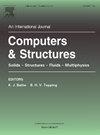Exact energy harvesting analysis of multimodal piezoelectric beams using the dynamic stiffness method
IF 4.8
2区 工程技术
Q1 COMPUTER SCIENCE, INTERDISCIPLINARY APPLICATIONS
引用次数: 0
Abstract
Piezoelectric vibration energy harvesting holds great potential for converting ambient vibrations into electrical energy. Establishing a suitable theoretical model to predict the performance of piezoelectric harvesters under base excitation is essential. This paper proposes a dynamic stiffness (DS) modeling technique to predict the electromechanical coupling responses of piezoelectric beams. The modeling technique is sufficiently general to be applied to a wide range of simple cantilever or generally complex piezoelectric beam structures. For demonstration purposes, this technique is applied to model beams equipped with three typical tip attachments and connected to three representative external circuits, enabling a comprehensive multimodal analysis. The Wittrick–Williams (WW) algorithm is employed to efficiently calculate the eigenvalues of DS matrices with any desired accuracy. This aids in tuning the natural frequency of piezoelectric beams to match the ambient environmental vibration frequency. The concepts of electrically-induced stiffness and electrically-induced damping are introduced to characterize the impact of energy harvesting circuits on natural frequencies and output voltage of piezoelectric harvesters. Theoretical research specifically conducted on piezoelectric beams explores the effects of material parameters, structural dimensions, load resistance, and base excitation on vibration energy harvesting. Finite element simulation confirms that the proposed DS model, based on the exact solution of governing differential equations, can accurately and effectively predict the output performance of piezoelectric harvesters. The proposed method can emerge as a powerful tool for the design and optimization of piezoelectric energy harvesters.
多模态压电梁的动力刚度精确能量收集分析
压电振动能量收集在将环境振动转化为电能方面具有巨大的潜力。建立一个合适的理论模型来预测压电采集器在基极激励下的性能是至关重要的。本文提出了一种动态刚度(DS)建模技术来预测压电梁的机电耦合响应。该建模技术具有足够的通用性,可广泛应用于简单悬臂梁或一般复杂的压电梁结构。为了演示目的,将该技术应用于配备三个典型尖端附件并连接到三个代表性外部电路的模型梁,从而实现全面的多模态分析。采用Wittrick-Williams (WW)算法以任意精度高效地计算DS矩阵的特征值。这有助于调整压电梁的固有频率,使其与环境振动频率相匹配。引入了电致刚度和电致阻尼的概念来表征能量收集电路对压电采集器固有频率和输出电压的影响。针对压电梁的理论研究探讨了材料参数、结构尺寸、载荷阻力和基座激励对振动能量收集的影响。有限元仿真验证了基于控制微分方程精确解的DS模型能够准确有效地预测压电采集器的输出性能。该方法可为压电能量采集器的设计和优化提供有力的工具。
本文章由计算机程序翻译,如有差异,请以英文原文为准。
求助全文
约1分钟内获得全文
求助全文
来源期刊

Computers & Structures
工程技术-工程:土木
CiteScore
8.80
自引率
6.40%
发文量
122
审稿时长
33 days
期刊介绍:
Computers & Structures publishes advances in the development and use of computational methods for the solution of problems in engineering and the sciences. The range of appropriate contributions is wide, and includes papers on establishing appropriate mathematical models and their numerical solution in all areas of mechanics. The journal also includes articles that present a substantial review of a field in the topics of the journal.
 求助内容:
求助内容: 应助结果提醒方式:
应助结果提醒方式:


